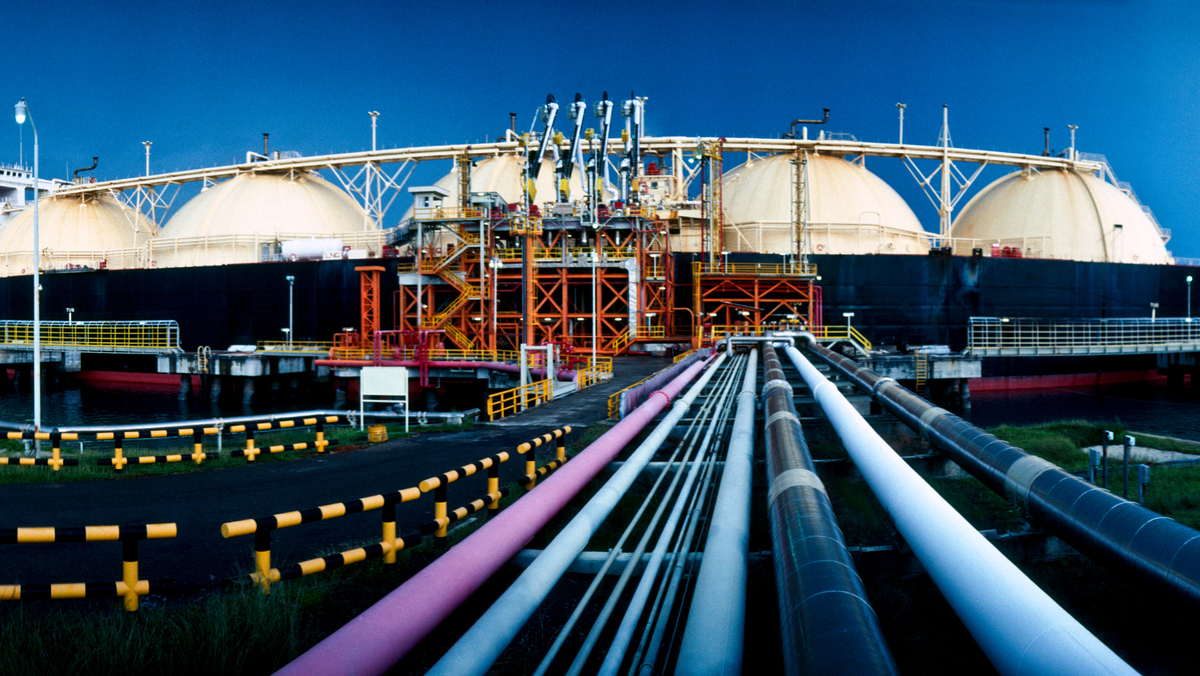LNG export terminals pose a growing and invisible threat: air pollution
Residents around existing LNG facilities in Louisiana already notice the smell and irritants from nearby terminals. With more under construction, air quality is poised to worsen.

Published in the Louisiana Illuminator
Headaches constantly plague Travis Dardar’s 11-year-old daughter and wife. There’s no need to go to a doctor for a diagnosis — Dardar’s family knows what’s causing them: the toxic emissions from Venture Global’s Calcasieu Pass Gas Export Terminal, the liquefied natural gas terminal less than a mile from where they live in Cameron Parish.
“It’s common sense when that much gas is leaking out of these plants,” says Dardar, 37, a fisherman and shrimper. “There’s always a smell, lots of smoke. And they want to claim it’s all clean. There’s no way. Go tell that to someone who doesn’t live next to one.”
LNG facilities are underreporting and miscalculating the amount of toxic air emissions from their facilities, according to a Jan. 10 report released by the Louisiana Bucket Brigade, a non-profit environmental advocacy group.
The pollution from LNG plants is only going to get worse, not just for Dardar, but for residents all along the Gulf Coast where five new LNG facilities are being built, eight more have received federal approval and five additional facilities have been proposed. Most abut low-income and/or minority communities already impacted by the oil and gas industry.
The emissions of carbon monoxide, sulfur dioxide and volatile organic compounds, among others, can irritate skin, eyes, nose and lungs and cause headaches, coughing, dizziness and other respiratory illnesses. Long-term exposure can lead to heart disease, certain types of cancer and damage to the reproductive system and internal organs. When contacted by Floodlight, the companies in this story and Louisiana regulators either did not respond, or said they were acting within the law.
Advocates warn this aggressive push for LNG will transform the coast into an industrial wasteland, destroy the commercial fishing industry and decimate the surrounding communities’ vitality.
“It’s like an alien invasion,” said Dardar. “My advice to the communities where these things are coming: try to stop them. Because once they get rolling, the flaring doesn’t stop. And they get to make up the rules as they go.”
The LNG epicenter
Dardar lives in what’s been called the epicenter of the Gulf Coast region’s buildout and expansion into liquefied natural gas. Cameron LNG, pegged as the country’s fourth largest LNG export facility, is also located in his hometown. Venture Global is set to build another export terminal right next door to his property.
The Jan. 10 report specifically cites Cameron LNG and Calcasieu Pass for burning off or releasing unpermitted amounts of chemicals that affect the residents of more than 700 homes around the facilities. Most of those chemicals, including hydrogen sulfide, carbon dioxide, and benzene, must be removed from the natural gas before it is frozen into a liquid for transport.
Sabine Pass, another LNG terminal in the area that came online last year, will increase the region’s carbon monoxide pollution by 39%, according to the Sierra Club. Late last year Sabine’s parent company, Cheniere, requested and was denied a permit from the EPA for an exemption to release more toxins associated with LNG processing, including formaldehyde and benzene. The company said that the exemption was needed in order to ship more LNG to Europe in the wake of the Ukraine war.
Advocates warn the push for LNG will transform the coast into an industrial wasteland, destroying the commercial fishing industry and stealing the vitality of the surrounding communities.
Loren Hopkins, a nationally recognized expert in environmental science and a professor at Rice University, says in addition to the unpermitted releases themselves, part of the problem is that federal and many state air quality standards set pollutant safety standards around single pollutant exposure.
“Nobody breathes one pollutant at a time,” she said. “They’re breathing mixtures from these facilities. The research that I’ve done indicates that when you’re breathing that mixture, even lower levels of exposure are triggering asthma attacks and cardiac arrest.”
The most alarming emission from LNG facilities is benzene, says Hopkins. There are no regulated safety levels for benzene, she said, but it is known to damage a person’s nervous system and cause cancer.
More than 3,000 pounds of the chemical was released by Cameron LNG during four instances of equipment failure between June and August 2022, according to incident reports filed with the state’s Department of Environmental Quality.
The Bucket Brigade’s report, and other environmental advocates, call out the Louisiana Department of Environmental Quality for failing to protect the communities surrounding existing LNG terminals by not properly investigating or taking action even when facilities do report accidents that lead to emissions releases exceeding their permitted limits.
“They just accept what these companies tell them,” said Wilma Subra, an environmental scientist with the Louisiana Environmental Action Network who has conducted her own research into emissions levels at existing LNG facilities.
Since full operations began in Aug. 2020, Cameron LNG has had 67 total accidental releases, which averaged out to about two per month due to repeated equipment failures according to the brigade’s report. Between August 2019 to December 2022 total emissions were equivalent to the same amount of greenhouse gasses as nearly 2,000 cars running continuously for a year.
Anya McInnis, a spokeswoman for Cameron LNG, said in an email the facility is in compliance with state and federal regulatory agency reporting requirements. “Together with our partners, Cameron LNG is committed to producing socially responsible LNG,” she wrote.
The brigade’s report states that LDEQ conducted two investigations, concluding in both that Cameron LNG had not complied with its air permit, but no penalties were levied against the facility for the violations. The group is asking for swift federal investigation and a halt on all buildout of existing and new LNG terminals until the state cracks down on regulation.
In an emailed statement, LDEQ spokesman Greg Langley said the agency responds to every documented complaint it receives about facilities, and it enforces the provisions of state-issued air emissions permits, citing that the investigation process and subsequent disciplinary actions can be a lengthy process.
“We, as a state agency, are always going to be protective of human health and the environment,” Langley wrote. “We operate within the rule of law.”
Langley did not respond to further questions asking about specific fines or actions resulting from LDEQ investigations.
Venture Global’s Calcasieu Pass facility, which began operating in February 2022, has reported two accidents related to emissions. But nearby residents are calling into question that report because of consistent flaring that goes on there.
Flaring at industrial facilities is used as an emergency tactic to burn off flammable gasses that are released during unplanned equipment failures. “The lack of accident reports at the facility while it flares regularly indicates that Venture Global is not reporting its operational problems,” the report says.
The report did not include emissions release estimates for Venture Global. The company, which is building another LNG export terminal in Plaquemines Parish, Louisiana, did not respond to a request for comment.
In her own research of the four operating LNG export terminals in the state, Subra found that emissions levels at Cameron LNG have gradually increased year-to-year between 2018 to 2020, with carbon monoxide jumping from 20 tons to 4,153 tons, and nitrogen oxides from 7 tons to 1,785 tons.
Hurricane Laura in August 2020 caused pressure system failure at nearby Sabine Pass LNG in Cameron resulting in the release of 51.5 tons of methane, 7.5 tons of nitrogen oxide and 64.4 tons of carbon monoxide, exceeding the facilities permitted limits, according to Subra’s research.
According to Subra’s reports LDEQ did not penalize those facilities for the incidents. The facilities also release other toxins and chemicals, such as dioxins and heavy metals, that neither the state nor the federal government require to be tracked or reported. Those substances, Subra said, “can be very toxic and bioaccumulate in the body.”
Floodlight depends on a community of readers like you who are committed to supporting nonprofit investigative journalism. Donate to see more stories like this one.


